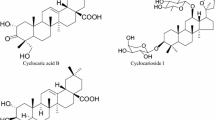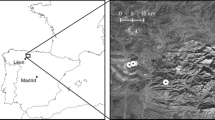Summary
Of ten terpenes that comprise most of the volatiles of grand fir foliage only four were affected by addition of nitrogen. Levels of beta-phellandrene, camphene and bornyl acetate and terpinolene were significantly reduced with nitrogen added to the equivalent amount of 44.8 g/m2. A quantity of 22.4 g/m2 did not affect terpene production. Several populations were examined and these did not respond consistently on a regional basis, yet a significant interaction effect was apparent between treatment and local population response. Overall, total yield of terpenes as a function of fertilization was not altered.
Similar content being viewed by others
References
Bazzaz FA, Chiariello NR, Coley PD, Pitelka LF (1987) Allocating resources to reproduction and defense. BioScience 37:58–67
Bernard-Dagan C (1988) Biosynthesis of lower terpenoids: genetic and physiological controls in woody plants. In: Hanover JW, Keathley DE (eds) Genetic manipulation of woody plants. Plenum Press, New York, pp 329–351
Bridges JR (1987) Effects of terpenoid compounds on growth of symbiotic fungi associated with the southern pine beetle. Ecol Epidemiol 77:83–85
Brooks JE, Borden JH, Pierce HD (1987) Foliar and cortical monoterpenes in Sitka spruce: potential indicators of resistance to the white pine weevil, Pissodes strobi Peck (Coleoptera: Curculionidae). Can J For Res 17:740–745
Bryant JP, Chapin FS, Klein DR (1983) Carbon nutrient balance of boreal plants in relation to vertebrate herbivory. Oikos 40:357–368
Bryant JP, Clausen TP, Reichardt PB, McCarthy MC, Werner RA (1987) Effect of nitrogen fertilization upon the secondary chemistry and nutrition value of quaking aspen (Populus tremuloides Michx.) leaves for the large aspen tortix (Choristoneura conflictana (Walker)). Oecologia (Berlin) 73:513–517
Campbell RK, Franklin JF (1981) A comparison of habitat type and elevation for seed-zone classification of Douglas-fir in western Oregon. For Sci 27:49–59
Cates RG, Redak RA, Henderson CB (1983) Patterns in defensive natural product chemistry: Douglas-fir and Western spruce budworm interactions. In: Hedin PA (ed) Plant resistance to insects. American Chemical Society Symposium, Ser 208. American Chemical Society, Washington, DC, pp 3–20
Charlwood BV, Banthorpe DV (1978) The biosynthesis of monoterpenes. Prog Phytochem 5:65–125
Clark RJ, Menary RC (1980) The effect of iriigation and nitrogen on the yield and composition of peppermint oil (Mentha piperita L.). Aust J Agric Res 31:489–498
Coley PD, Bryant JP, Chapin FS (1985) Resource availability and plant antiherbivore defense. Science 230:895–899
Croteau R (1984) Biosynthesis and catabolism of monoterpenes. In: Nes WD, Fuller G, Tsai L-S (eds) Isopentenoids in plants. Marcel Dekker, New York, NY, pp 31–64
Fretz TA (1976) Effect of photoperiod and nitrogen on the composition of foliar monoterpenes of Juniperus horizontalis Moench. cv Plumosa. J Am Soc Hortic Sci 101:611–613
Gershenzon J (1984) Changes in the levels of plant secondary metabolites under water and nutrient stress. Recent Adv Phytochem 18:273–320
Honover JW (1966a) Genetics of terpenes. I. Gene control of monoterpene levels in Pinus monticola Dougl. Heredity 21:73–84
Hanover JW (1966b) Environmental variation in the monoterpenes of Pinus monticola Dougl. Phytochemistry 5:713–717
Haukioja E, Niemela P, Siren S (1985) Foliage phenols and nitrogen in relation to growth, insect damage, and ability to recover after defoliation, in the mountain birch Betula pubescens ssp tortuosa. Oecologia (Berlin) 65:214–222
Larsson L, Wiren A, Lundgren L, Ericsson T (1986) Effects of light and nutrient stress on leaf phenolic chemistry in Salix dasyclados and susceptibility to Galerucello lineola (Coleoptera). Oikos 47:205–210
Maddox GD, Cappuccino N (1986) Genetic determination of plant susceptibility to an herbivorous depends on environmental contex. Evolution 40:863–866
Margolis HA, Waring RH (1986) Carbon and nitrogen allocation patterns of Douglas-fir seedlings fertilized with nitrogen in autumn. I. Overwinter metabolism. Can J For Res 16:897–902
Mihaliak CA, Lincoln DE (1985) Growth pattern and carbon allocation to volatile leaf terpenes under nitrogen-limiting conditions. Oecologia (Berlin) 66:423–426
Mihaliak CA, Couvet D, Lincoln DE (1987) Inhibition of feeding by a generalist insect due to increased volatile leaf terpenes under nitrate limiting conditions. J Chem Ecol 13:2059–2067
Phillips R, Henshaw GG (1977) The regulation of synthesis of phenolics in stationary phase cell cultures of Acer pseudoplatanus L. J Exp Bot 28:785–794
Pollack JC, Dancik BP (1985) Monoterpene and morphological variation and hybridization of Pinus contorta and Pinus banksiana in Alberta. Can J Bot 63:200–222
Rudloff E von (1976) Chemosystematic studies in the genus Abies II. leaf oil analysis of grand fir. Can J Bot 54:1926–1931
SAS Institute, Inc (1985) SAS Users Guide: Statistics. Cary, NC
Schopf R (1986) The effect of secondary needle compounds on the development of phytophagous insects. For Ecol Manag 15:55–64
Smith RH (1964) Variation in the monoterpenes of Pinus ponderosa Laws. Science 143:1337–1338
Squillace AE (1976) Analyses of monoterpenes of conifers by gasliquid chromatography. In: Miksche JP (ed) Modern methods in forest genetics. Spring, Berlin Heidelberg New York, pp 120–157
Waring RH, McDonald AJS, Larsson S, Ericsson T, Wiren A, Arwidsson E, Ericsson A, Lohammar T (1985) Differences in chemical composition of plants grown at constant relative growth rates with stable mineral nutrition. Oecologia (Berlin) 66:157–160
Wilkinson RC (1985) Comparative white pine weevil attack susceptibility and cortical monoterpene composition of western and eastern white pine. For Sci 31:39–42
Zavarin E, Snajberk K, Critchfield WB (1977) Terpenoid chemosystematic studies of Abies grandis. Biochem Syst Ecol 5:81–93
Author information
Authors and Affiliations
Rights and permissions
About this article
Cite this article
Muzika, R.M., Pregitzer, K.S. & Hanover, J.W. Changes in terpene production following nitrogen fertilization of grand fir (Abies grandis (Dougl.) Lindl.) seedlings. Oecologia 80, 485–489 (1989). https://doi.org/10.1007/BF00380070
Received:
Issue Date:
DOI: https://doi.org/10.1007/BF00380070




